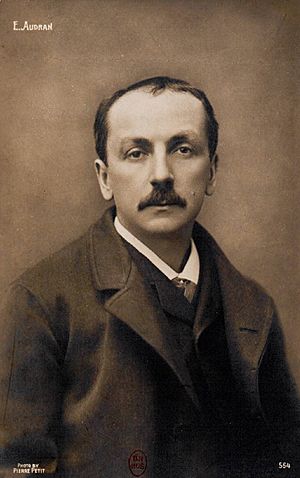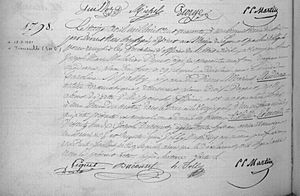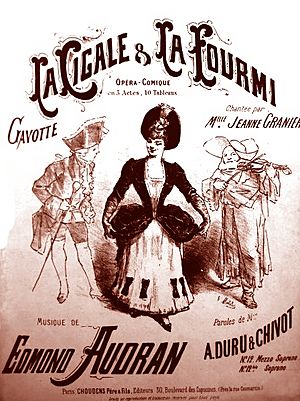Edmond Audran facts for kids

Achille Edmond Audran (born April 12, 1840 – died August 17, 1901) was a French composer. He is famous for writing many popular comic operas and operettas. His works were enjoyed all over the world.
Audran started his music career in Marseille as an organist. He wrote religious music and began creating stage shows in the 1860s and 1870s. His show Le grand mogol (1877) was very popular. It was later performed again in Paris, London, and New York. In 1879, he moved to Paris. There, many of his pieces became very successful in France and other countries. These included Les noces d'Olivette (1879), La mascotte (1880), Gillette de Narbonne (1882), La cigale et la fourmi (1886), Miss Helyett (1890), and La poupée (1896).
Most of his works are not performed much today. However, La mascotte is still sometimes brought back to the stage. It has also been recorded for people to listen to.
Contents
Early Life and Music Beginnings
Audran was born in Lyon, France. His father, Marius-Pierre Audran, was a tenor singer at the Opéra-Comique. Edmond studied music at the École Niedermeyer. He won a prize for his compositions in 1859. In 1861, his family moved to Marseille. His father became a singing teacher there. He later became the director of the music school.
Edmond Audran became the organist at St Joseph's church in Marseille. He wrote religious music for the church. In 1873, he wrote a mass (a type of church music). This mass was also performed in Paris. Audran first wrote music for the stage in Marseille. His first show was L'Ours et le Pacha (1862). It was a musical version of a play. He then wrote La Chercheuse d'Esprit (1864), a comic opera. Audran also composed other pieces. These included a funeral march and some songs in the local Provençal language. He is mostly known for his light operas.
Big Successes with Operettas
While still in Marseille, Audran wrote several operettas. An operetta is a type of light opera with spoken dialogue and singing. The most successful of these was Le grand mogol (1877). He worked with writers Henri Chivot and Alfred Duru on this show. They revised it for a Paris production in 1884.
Audran moved to Paris in 1879. He quickly became successful with Les noces d'Olivette (1879). This show was very popular. It soon went to London, where it was called Olivette. It played for over a year there. A critic at the time said Audran was very good at capturing the feeling of the places in his music.
After moving to Paris, most of Audran's stage works first opened there. Then they were performed in other countries. However, some of his works premiered elsewhere. These included La paradis de Mahomet (Brussels, 1887) and Indiana (Manchester, 1886). The show La mascotte (1880) was a huge hit in Paris. Audran signed a contract to write only for the Bouffes-Parisiens theatre for five years. He worked with many different writers. His most frequent partners were Maxime Boucheron, Chivot, Duru, and Maurice Ordonneau.
Audran's music was as popular in England as it was in France. Most of his works were performed in English versions in London. Some of his most successful comic operas were:
- Le grand mogol (Marseille, 1877; Paris, 1884; London, 1884; New York, 1881).
- La mascotte (Paris, 1880; New York, 1881; London, 1881).
- Gillette de Narbonne (Paris, 1882; London, 1883).
- La cigale et la fourmi (The Grasshopper and the Ant) (Paris, 1886; London, 1890).
- Miss Helyett (Paris, 1890; London, 1891).
- La poupée (Paris, 1896; London, 1897).
Later Years and Legacy
In his last years, Audran became unwell. He had to stop working in Parisian society. He passed away in Tierceville, France, when he was 61 years old.
In 1957, a music critic named Philip Hope-Wallace wrote about Audran. He said that people who listen to seaside bands might know Audran's name. This is because his music from shows like La Mascotte and Miss Helyett still made people want to tap their feet. The critic felt Audran was a very good composer, even if he wasn't as famous as Offenbach. Audran himself didn't think La Mascotte was his best work. He thought his other pieces were more clever.
Not many of Audran's works have been recorded. However, a French recording of La mascotte was made in 1957. La mascotte is also famous for bringing the word "mascot" into the English language. The Oxford Dictionary of Word Origins explains this. The French operetta La Mascotte premiered in 1880. The word first appeared in English the next year. The French word "mascotte" comes from "masco," meaning 'witch' in a southern French dialect. At first, a mascot just meant 'a person or thing thought to bring good luck'. It didn't have to be carried or shown, like it often is today.
Stage works
See also
 In Spanish: Edmond Audran para niños
In Spanish: Edmond Audran para niños




